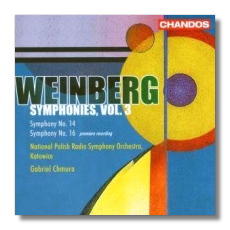
The Internet's Premier Classical Music Source
Related Links
- Latest Reviews
- More Reviews
-
By Composer
-
Collections
DVD & Blu-ray
Books
Concert Reviews
Articles/Interviews
Software
Audio
Search Amazon
Recommended Links
Site News
 CD Review
CD Review
Mieczysław Weinberg

Symphonies, Volume 3
- Symphony #14, Op. 117
- Symphony #16, Op. 131
National Polish Radio Symphony Orchestra, Katowice/Gabriel Chmura
Chandos CHAN10334 DDD 63:42
This is Volume 3 in Chandos' Weinberg symphony cycle. Volume 1 (CHAN10128) contains the Fifth Symphony and the Sinfonietta #1, and Volume 2 (CHAN10237) contains the Fourth Symphony, the Sinfonietta #2, and the Rhapsody on Moldavian Themes.
Weinberg (1919-1996) is a very interesting composer who finally seems to be getting his due. In the past, there even was confusion about his name, which was incorrectly spelled "Moysey Vainberg." Unlike many Poles at the start of World War Two, Weinberg fled not to the West but east – specifically, to the Soviet Union. After the war, Weinberg remained there and was, for all intents and purposes, a Soviet composer, despite his Polish birth. He and Shostakovich were on friendly terms, and apparently he was one of the few Soviet composers whose music Shostakovich genuinely appreciated. Like many Soviet composers, however, Weinberg experienced difficulties – not just because of his music, but because of his Jewish background. As much as the powers-that-were in the Soviet Union publicly denied it, anti-Semitism was a part of that society.
The two symphonies on this CD were premièred during the Second (1980) and Fourth (1982) Moscow Autumn Festivals, and both were praised at their appearance. That this is the Sixteenth Symphony's première recording is a rather surprising truth, as this is a major work, full of strong ideas strikingly treated. While sectional, this is a 33-minute symphony in one continuous movement, and with an overarching sonata form. Weinberg's music often is compared to that of Shostakovich. That's true in this symphony, but here, the similarities are not so much stylistic as they are related to both composers' mastery of chamber music-like sonorities within writing for the full orchestra. Many of the first-chair players receive heartfelt solos as the symphony progresses from the implacably pounding drama of the opening to the haunted calm of the symphony's last bars.
The Fourteenth Symphony also is in a single movement, although here, the skeleton of traditional four-movement structure can be discerned underneath the surface. As in the Sixteenth Symphony, the mood is serious, but not grim. Even so, there's bitterness and mockery in this symphony. This is another link with Shostakovich, although in the second movement, a sometimes frightening Allegro, the melodic and rhythmic contours are more reminiscent of Bartók's or Kodály's music. Again, in its emotional depth and breadth, its distinctive orchestration, and its expert construction, this strikes me as another major addition to the symphonic repertoire.
Chmura and the Polish orchestra also were heard in Volumes 1 and 2. The National Polish Radio Symphony of Katowice sometimes sounds as if they are challenged by the music, but the first-chair players give an outstanding account of themselves in both symphonies. The lasting impression left by these performances is one of commitment to the music, and Chmura, who was born in Poland and raised in Israel, knows what he is doing. Chandos' fine engineering and good booklet notes by Per Skans add to the desirability of this release.
Copyright © 2007, Raymond Tuttle




















